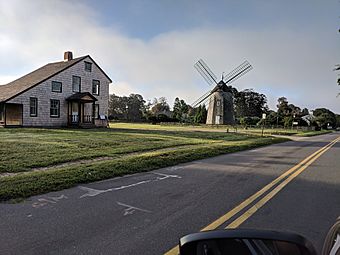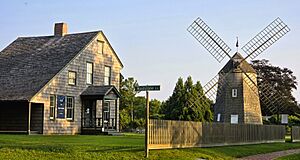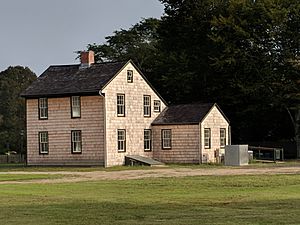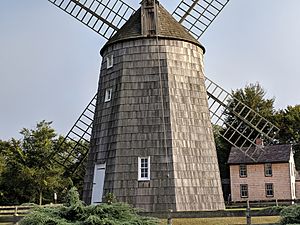John Lyon Gardiner Mill Cottage facts for kids
Quick facts for kids |
|
|
John Lyon Gardiner Mill Cottage
|
|
|
U.S. Historic district
Contributing property |
|

Replica saltbox home and gardiner mill as seen in September 2018
|
|
| Location | 36 James Lane, East Hampton, New York |
|---|---|
| Architect | John Lyon Gardiner |
| Part of | East Hampton Village District (ID74001309) |
| Designated CP | May 2, 1974 |
The John Lyon Gardiner Mill Cottage is a special museum in East Hampton, New York. It sits on the historic East Hampton Village green. This cottage is now a museum that shows beautiful landscape paintings from the 1800s and early 1900s. It is an important part of the East Hampton Village District, which is listed on the National Register of Historic Places. The cottage is located near a historic windmill and a marker for Rev. James.
Contents
History of the Cottage and Mill
In 2014, the Town of East Hampton bought the Gardiner Mill cottage and its land. This purchase also included the Gardiner windmill, which was built in 1804. The community asked for this purchase, and it was paid for using special preservation funds.
Later in 2014, the village agreed to build a new cottage. This new building would be a copy of an old colonial-era "saltbox" style home. The village decided to be fully responsible for creating a museum there.
Terry Wallace, who owns the East Hampton Wallace Gallery, helped with the museum. He agreed to donate some of his collection of landscape paintings. These paintings show scenes of the Hamptons, with some dating back to 1865. Other paintings for the museum were bought with money from the Robert David Lion Gardiner Foundation.
About the Cottage Building
The original mill cottage was a colonial-era building made with a timber frame. It was built in the "saltbox" style, which means it has a long, sloping roof at the back. The cottage was restored to look like it did in the 1880s. This was when Jonathan Thompson Gardiner last updated it.
In the early 1900s, an artist named Percy Moran lived in the cottage. He was the nephew of the famous artist Thomas Moran. Over time, the cottage became quite run-down. Instead of just fixing the old building, it was decided to replace it with a new, exact copy. This was a way to keep the historical look while making sure the building was strong and safe.
Some parts that were added to the original cottage over the years, like porches and dormers (windows that stick out from the roof), were removed. The front porch, which was added in the 1880s, was rebuilt. An old kitchen area was also recreated. This new space was designed to be an entrance and a bathroom. These changes made the museum accessible for everyone, following the Americans With Disabilities Act. A small parking lot was also added behind the cottage. This was done so that cars would not block the view from the street.
About the Mill Building
The Gardiner Mill was built in 1804. It is a "smock windmill" built in the New England style. A skilled builder named Millwright Nathanial Dominy V constructed it. This mill worked as a grist mill, which means it ground grain into flour for local farmers.
The wood used to build the mill came from trees on Gardiner's Island. The mill was finished on September 28, 1804. It cost more than 528 pounds to build, which would be about $28,208 today. The mill continued to operate until 1900.
The Gardiner Mill still has most of its original machinery inside. It shows the best example of colonial-style interior work among the windmills still standing on Long Island. It also highlights the amazing craftsmanship of Nathaniel Dominy V. He built other windmills in the area too. Nathaniel Dominy was known for paying great attention to detail. He even smoothed the timbers of the Gardiner Mill frame by hand. He made this extra effort because it was a new type of windmill. This mill was designed to run two sets of millstones instead of just one. He also built it for an important person, John Lyon Gardiner. The village completely renovated the windmill in 1996. This restoration made the windmill state-of-the-art while keeping its historical accuracy.
Images for kids
See also







